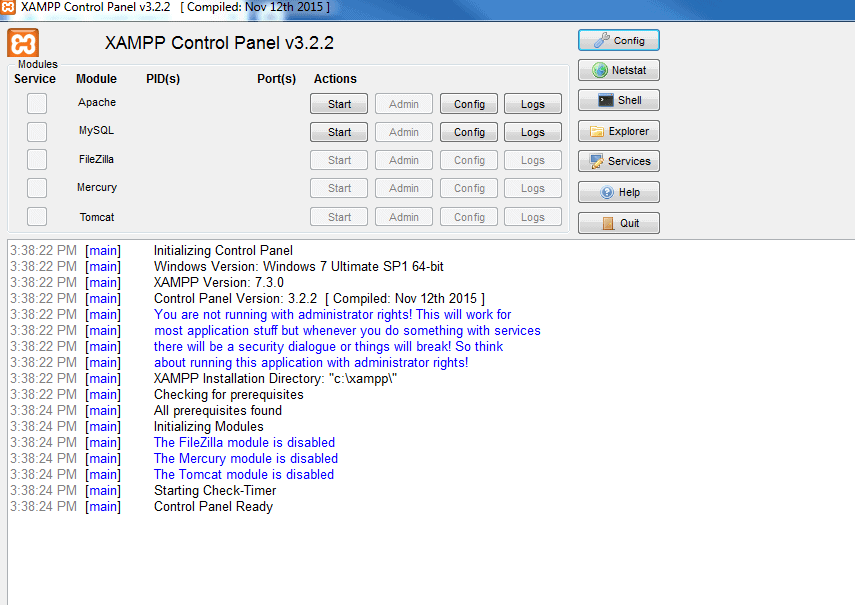Are you new to building websites and as a newbie worried about how to handle XAMPP and work with your website? Stay calm and read the article about XAMPP. You will come to know the nook and corner of XAMPP and in what ways it benefits you.
XAMPP is an open-source cross-platform web solution that was developed by Apache friends in September 2002. Developers are still using XAMPP because it is easier to use and even beginners can handle XAMPP in a simple way. Before entering into XAMPP let’s have a quick knowledge about localhost.
What is XAMPP?
XAMPP stands for Cross-platform, Apache server, Mysql, PHP, and Perl. It is a free open source software that contains Apache distributions for Apache servers, MariaDB, PHP, and Perl. And it is basically a localhost or a local server. This local server works on your own desktop or laptop computer.
This local web server allows developers and programmers to create, write, and test their programs locally. This XAMPP server software gives you a suitable environment for testing MYSQL, PHP, Apache, and Perl projects on the local computer.
XAMPP Components
XAMPP Components are explained below
X-Cross platform:
Cross-platform is basically computer software that is designed to work on several computing platforms or operating systems. It is also called multi-platform or platform-independent. It can run multiple applications such as Windows, macOS, Linux, etc.
The benefit of cross-platform is that when an application runs on more than one platform, the user can use the software for wider devices and computers. In XAMPP cross-platform components are included to increase the utility and reach of the apache distribution packages.
A – Apache:
Apache server is open-source free software that is initially developed by a group of software developers and now it is maintained by Apache software foundation.
Apache HTTP is a remote server(computer) if someone requests files, images, or documents using their browser they will serve those files to clients using HTTP servers. Mainly hosting companies use this application to create a VPS server and shared hosting for their clients.
M – Mysql:
MYSQL is open-source software. It is actually a relational database management system(RDBMS). This SQL stands for Structured Query Language. It is the most popular and best RDBMS used for developing a variety of web-based software applications.
With the help of MYSQL, it is possible to organize the information, manage, retrieve, and update the data whenever you wish to do it. Initially, Mysql was used as a database. Now MariaDB is replaced in the place of Mysql.
M – MariaDB:
MariaDB is the most popular open-source relational database, developed by the Mysql team. This database offers services such as data storage, arrangement, retrieval, deletion, and manipulation through the internet.
MariaDB and Mysql are quite different. MariaDB gives you better performance than MySQL. It supports different stored engines.
P – PHP:
The full form of PHP is Hypertext Preprocessor. It is a server-side scripting language that helps you to create dynamic websites. This language is mainly used to build web-based software applications.
It is open-source software and works fine with MYSQL. What actually happens is, the PHP code will be executed on the server, and on the browser side its HTML code will be displayed.
P – Perl:
Perl is usually said to be the general-purpose programming language. This Perl language is interpreted and highly dynamic. Actually, this language is used for web development, GUI development, system administration, etc. Perl is capable of working with HTML, XML, and other markup languages.
In the latest version of XAMPP, there are additional tools such as Mail server Mercury, OpenSSL, phpMyAdmin, etc.
phpMyadmin:
Phpmyadmin is a tool that is used to deal with Mariadb. The main role of PHPMyAdmin is to administrate the DBMS. The latest version of PHPMyAdmin is 4.0.4. This tool is written in PHP to perform all administration tasks, running queries, creating databases, and adding user accounts.
OpenSSL:
OpenSSL is an open-source implementation tool that contains Secure Socket Layer Protocol and Transport Layer Protocol. It is licensed under an Apache-style license, which means you are free to get and use it for commercial and non-commercial purposes. It is used to identify certificate information, generate private keys, install SSL/TLS certificates, and create CSRs.
Other Components in XAMPP:
XAMPP Control Panel is actually a management tool that is used to supervise the other components of XAMPP. The user can start and halt modules by operating the button under the Action column.
Webalizer:
Webalizer is a free, open-source web analytics software program that keeps track of apache user logs, website statistics. It gives you detailed, easily configurable usage reports in HTML format.
Mercury:
Mercury is a local mail server that is used to manage and send emails across the web.
Tomcat:
Tomcat is the most popular Java application server. It is a java based servlet that provides all the java functionalities.
FileZilla:
FileZilla is an open-source cross-platform File Transfer Protocol used to transfer files from a local computer to a remote computer. It is available in both server and client versions.
XAMPP File Formats
The three file formats are .exe, .7z, and .zip
.exe → This represents the executable files. This is mainly used to install because you can run this file on any computer as a normal program.
.7z→ 7zip file used to represent compressed files that support multiple data compression and encryption algorithms.
.zip→ It supports lossless compression of files and also multiple compressed files. In this format, the deflate algorithm is used for the compression of files.
Both .7z and .zip files are quite tricky to use as compared to .exe.
Control Panel
In the control panel, you will be able to control individual components of your text server. Here you can start or stop individual modules by clicking the buttons below “Actions”. The control panel contains various buttons like config, net stat, shell, explorer, services, help, quit.

Config → It allows you to configure the XAMPP as well as the individual components
Netstat → Helps you to show all the currently running processes on the local system
Shell → It allows opening UNIX shell
Explorer → It will open the XAMPP folder in windows explorer
Services → Help to show all the services that are currently running in the back-end
Help → As the name implies it gives you links to the user forums
Quit → By clicking the button the XAMPP control panel will exit
Pros and Cons of XAMPP
Advantages of XAMPP
- It is a free, open-source software
- Easy to use and install even for the newbies
- Since it is cross-platform, it works effectively on Windows, Linux, and Mac OS
- You will be able to Start and Stop web servers and database stacks with just single command
- XAMPP is available in both full and standard version
- Can work along with CMS like WordPress, Joomla, Drupal, Magento, Opencart, etc.
Disadvantage of XAMPP
- The only disadvantage of XAMPP is that its configuration and settings are quite difficult as compared to WAMP servers.
Conclusion
XAMPP software emulates a remote server-like environment on your local computer. As an app developer, you need to test applications as many times as possible to find and fix the bugs. If you are testing in a local environment like XAMPP, it will speed up your development process.
Before XAMPP every time you need to upload files to a remote server for testing purposes. It will be quite difficult to test on the live server and it is visible to your visitors. But whereas in XAMPP you can easily test and make any updates in your local host.
At any number of times, you can update and test in XAMPP. Once completed you can upload these new updated files to the remote server. XAMPP plays a great role when it comes to web designing and development.
Hope this article would have helped you to gain knowledge about XAMPP. If you have any queries regarding this article or if you have any suggestions please feel free to comment. Your suggestions will help us to improve our article.
